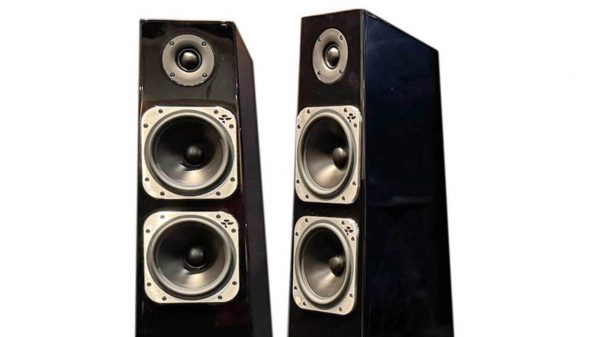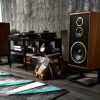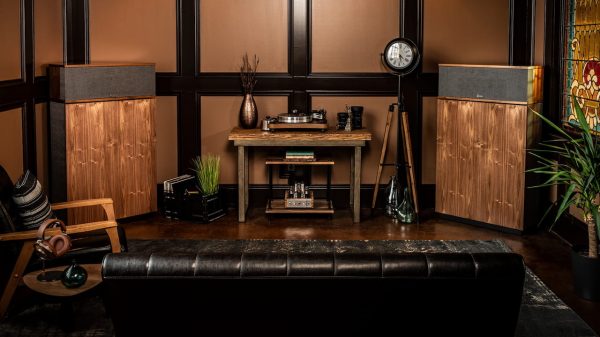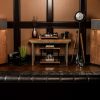Consumers and manufacturers love to wax poetically about “vintage” when it comes to loudspeakers and amplifiers but I’m not sure I buy into it as much when it comes to most vintage loudspeakers. Vintage speakers require a lot of work and some luck if the previous owners have been less than gentle with them.
A clumsy mover destroyed a pair of vintage Celestion Ditton 33 MKIIs that I had taken care of for over 13 years without a scratch. Getting the drivers replaced wasn’t very easy and the cabinets were a loss.
Nostalgia is one powerful drug. The vinyl revolution was certainly inspired by a heavy dosage of it but that isn’t enough to sustain a movement. What has given vinyl’s unexpected comeback some solid legs is that millennials have discovered the benefits of ownership; the generation that grew up on iTunes and Spotify finally have a physical piece of media that they can own – just like their parents and older siblings.
Loudspeaker manufacturers have taken that newfound interest in nostalgia and reintroduced updated versions of their most popular vintage audio speakers with a great deal of success so far.
Products like the Wharfedale Linton Heritage and Klipsch Forte IV loudspeakers are all the proof one requires.
Mission’s most recent success with the Mission 770 Loudspeakers that sell for a rather lofty $4,600 USD has only helped to push more consumers into the “vintage” category.

All of the loudspeakers on our list have sold well; the Linton Heritage has been an enormous success for Wharfedale and for good reason.
Supply chain issues and inflation have also made all of them more expensive. Our prices below have been updated to reflect an increase of over 10% or more for all of them so far in 2022.
The Linton Heritage have jumped from $1,499 to $1,799 USD which is not an insignificant amount of money if you are working with a tight budget.
The JBL have increased by $400 and the Klipsch are now $5,000 USD which is a $500 increase from January.

KLH Audio is back in the game now with the brand new KLH Model Five ($2,498/pair at Amazon or Crutchfield) that has earned rave reviews from both the press and consumers. Eric Pye has his rather in-depth review forthcoming.
The company started by Henry Kloss, Malcom Low, and Josef Anton Hofmann in 1957 sold over 30,000 pairs of loudspeakers before it was sold off in 1964; the brand had numerous owners including Kyocera who stopped manufacturing audio components in 1989.
KLH Audio is a new company owned by Klipsch and VOXX executive, David P. Kelley. The vintage audio vibe is very strong with the Model 5 and the backlog of orders is considerable.
Vintage audio has never been more popular; our two weekly columns deliver consistent traffic and comments that match the response to our most popular reviews of new products.
The interest in vintage audio loudspeakers has never been higher; especially as brands continue to refresh popular models that have been around longer than most millennials who are getting into better sound quality for the first time.
Quality matters. Especially when there is a premium attached to ownership.
Consumers are willing to spend a lot of money; often more than the price of a new high-end system, for really rare vintage audio components from brands like McIntosh, Mark Levinson, Krell, and Quad – so it should not surprise anyone that people are very interested in new loudspeakers from some of the oldest high-end brands that pay homage to classic designs that once occupied the front covers of every Hi-Fi magazine.
JBL, Klipsch, and Wharfedale have been manufacturing award-winning loudspeakers for almost 73 years; all three companies entered the loudspeaker business in 1946 run by three visionaries who had spent the previous decades working on loudspeaker drivers for other audio components such as radio consoles and movie theater loudspeaker systems. It is a remarkable bit of history that all three brands not only still exist but are category leaders and some of the most popular in the world.
All three have survived generational changes in listening habits, format wars, advancements in amplification technology, the home theater revolution, and the shift to active and wireless loudspeakers.
All of our selections have an old-school aesthetic but sound nothing like their predecessors; these are modern sounding loudspeakers with advanced driver technology and certainly require quality amplifiers and sources. Green shag carpeting is optional.
Wharfedale Linton Heritage

Wharfedale’s founder, Gilbert Briggs built his first loudspeaker in 1932 in his home in Ilkey, Yorkshire; the town was based in the valley of the river “Wharfe.” Briggs opened Wharfedale Wireless Works in 1933 supplying advanced loudspeaker drivers to the growing radio industry and the company became a leading supplier selling more than 9,000 units per year until the outbreak of World War II. The company flourished after the war and became one of the first companies to offer a two-way loudspeaker in 1945 – the prototype for the modern loudspeaker.
Wharfedale introduced the original Linton in 1965 and the model which utilized three drive units developed a strong following with its smooth midrange, punchy low end, and sense of scale. The model disappeared from their line-up in the 1970s but was recently reintroduced as the stand-mounted Linton Heritage. Wharfedale has also designed a custom stand for the Linton Heritage that puts the tweeter around 36” from the floor and includes room for records as well.
The three-way loudspeakers are larger than most bookshelf loudspeakers making the stands a logical accessory to maximize their performance. The modern Linton feature an 8-inch Kevlar cone woofer, 5-inch Kevlar cone midrange driver, and 1-inch soft dome tweeter. Listeners may decide to ditch the woven grille covers, but we think they give the Linton that old-school look that makes them stand out.
Wharfedale designed the Linton with two rear ports which requires giving these loudspeakers some distance from the wall behind them; the 8-inch woofer can deliver the goods playing Led Zeppelin with only 20 watts so don’t confuse old with polite. The Linton Heritage offer all of the midrange resolution and natural sound of the original, but with a lot more detail, speed, and transparency.
They deliver scale and image rather well considering their boxy looking cabinet. If your budget can stretch to $1,500 which includes the stands, the Linton should be on your short list.
The Linton Heritage can work well with a lot of different amplifiers; Audiolab, Cambridge Audio, Naim, Croft Acoustics, Creek, and vintage amplifiers from Marantz, Audio Research, and Sansui are all solid options.
Where to buy: $1,799/pair at Amazon | Crutchfield
JBL L-100 Classic

James Bullough Lansing founded JBL in 1946, after the death of his partner, Ken Decker, with whom he had spent twenty years developing successful speaker drivers and movie theater sound systems under the Lansing Manufacturing Company brand name. Decker had been responsible for the business end of Lansing and his demise sent the company into a financial tailspin until it was acquired and renamed as Altec Lansing in 1941.
Both companies went their separate ways and Lansing introduced several innovative Alnico drivers that became signature JBL products over the decades. Lansing died in 1949, but the company pushed forward under the guidance of JBL’s vice-president, Bill Thomas. JBL was eventually acquired by Sidney Harman who turned the brand into the world leader in pro audio, movie theater loudspeakers, and high-end systems that exists today.
JBL introduced the original L-100 Century in 1970 and they soon became one of the best-selling loudspeakers of all-time. Priced at $250 each, The L-100 Century were derived from JBL’s 4310 studio monitors and the home version were fussy beasts that needed space and a lot of power.
The L-100 were detailed and dynamic sounding loudspeakers that worked well with classic rock but were not the last word in refinement. Their trademark orange, blue, or black foam grille covers are still coveted by collectors today.
JBL re-introduced the L-100 Classic in 2018 and after the sticker shock wore off, audiophiles discovered that decades of driver innovation at JBL were something to appreciate in the new design.
The L-100 Classic utilize JBL’s pure-pulp cone five-inch midrange drivers, 12-inch bass driver, and 1-inch Titanium dome tweeter in a stand-mounted loudspeaker that deliver all of the accuracy of the world’s best studio monitors, but with a lot more finesse and a warmer tone than the original.
The L-100 Classic still require a lot of space and a powerful amplifier, but they fill a large room with ease and are one of the most dynamic sounding loudspeakers available for the price. If you crave an intense listening experience, the JBL are well worth an audition.
Where to buy: $4,400/pair at AudioAdvice.com | Crutchfield
Klipsch Forte IV

There are few American loudspeaker brands as iconic as Klipsch. Founded by the late-Paul W. Klipsch in 1946 in a tiny shed in Hope, Arkansas, Klipsch has remained true to its founder’s ideals for more than seven decades. Paul Klipsch developed the legendary Klipschorn with the premise of recreating the sound of live music in the home.
The corner horn Klipschorn have been in production for over 70 years and still deliver on Klipsch’s four key design elements: high-efficiency/low distortion, controlled directivity, wide-dynamic range, and flat-frequency response.
Paul Klipsch designed loudspeakers that were easy to drive, directed sound directly towards the listener in an attempt to minimize the room’s impact on soundstage depth and width, could reproduce both the quietest and loudest sounds with both clarity and free of distortion, and sounded as transparent and uncolored as possible across the entire frequency spectrum.
The Klipsch “sound” has remained true to Paul’s technical goals but the boldness of the presentation hasn’t always been for everyone. The physical size of the Klipschorn doesn’t make them practical for most rooms, but the Heritage Forte IV loudspeakers are one of the most engaging loudspeakers available and the updated version are much easier to use in most listening spaces – with a few caveats.
The Forte was introduced in 1985, but there is considerable daylight between the original and the latest version that still looks like something your father had in his living room in the 1970s. The Forte IV are large, heavy, and unlikely to impress initially with their dated look.
All of that changes the moment you drive the super-efficient Forte IV with 10-15 watts of tube power and put some distance between the loudspeaker and your listening position. Music pours out of the Forte IV’s drivers and smacks you in the face; in a good way that becomes more natural sounding once you get over the shock. This refreshed vintage audio speaker sounds much more dynamic than a lot of other new designs.
Unlike other Klipsch models which can sound bright and forward sounding, the Forte IV sound more restrained without sacrificing the tone, dynamics, and sense of realism that they deliver. All genres of music work with the Forte IV and with warmer sounding amplifiers and sources, they make a lot of really super expensive audiophile loudspeakers sound rather lifeless.
Where to buy: $4,998/pair at Amazon | Crutchfield
Also available in Canada for $7,798/pair at Amazon.ca










































Mike Cornell
May 20, 2021 at 12:54 pm
I know it’s the new(old) kid on the block, but the KLH Model Fives are conspicuous in their absence from this article.
Ian White
May 20, 2021 at 2:29 pm
Mike,
Currently under review and we’ve listened to the other 3 before including.
But yes – the KLH Model Fives will likely get added based on early impressions.
Best,
Ian White
Mike Cornell
May 20, 2021 at 10:33 pm
A little bit off-topic but I’ve got to compliment you on this site, Ian. I discovered it a few months back and it’s become one of my favourite audio/music sites. Love the emphasis on vintage and entry level….just great information all around. Appreciate the Canadian references as well….the mentions about CFNY brought back some great memories. Keep up the great work!
Ian White
May 21, 2021 at 1:24 am
Mike,
Very kind of you to say. We have some really big plans for the site. Just recorded two new podcasts which should be out next week and even more focus on vintage, music, and affordable audio.
Best,
Ian White
Brett Bradford
April 11, 2023 at 6:08 pm
I’m rocking a pair of Pioneer HPM100’s, a very under rated speaker with a pair of JBL 4312C monitors through a Marantz 2230 and little cheap Teac EQ. Not a lot of power at all and i have blown 2 low powered receivers driving this setup. As long as I keep the volume below 1 O’clock everything is cool. They sound magical, although I’m sure they could give up more. To me high volume is not really high fidelity. Moderately loud is as far as I go and the 2230 gets great reviews for being one of the warmest solid state Marantz. I have had that set up (partially) since I was 15 and never get tired of it. I have amazed many ears with my set.
Bruce Morgen
May 22, 2021 at 6:41 am
I don’t recall the original JBL L-100s as being especially power-hungry, especially compared to “East Coast Sound” competitors like the AR-3A and KLH 5. They could rock out pretty hard when driven by a decent 50-60 WPC receiver. Back in the day, we often sold them paired up with classic Japanese amplifiers like Kenwood’s KA-6000 (and the successor KA-7002) — or a McIntosh MC-2505 power amp with a C-26 preamp.
Thanks for the trip down audio memory lane, Ian.
Henry
May 10, 2022 at 4:14 pm
Classic 30-40year old speakers are generally more accurate across the frequency spectrum, yielding a smoother/more believable sound. Mainly due to larger bass drivers, basically because low end frequencies are “longer wavelength”. The modern habit of producing units with multiple smaller drivers does not always make for a natural bottom end. Having auditioned many quality brands with bitter disappointment, I have ALWAYS come back to my 20-30 year old Tannoys, Spendor and not forgetting the majestic Magisters.
How can tiny 6″ drivers produce realistic bass, low frequencies naturally suffer as a result, often too weak to project in a suitable environment.
Even electrostatics need bass bins as part of the system, typically modern modules. I had for some years coveted a pair of Quad ESL57s, however, was bitterly disappointed with performance, with low end output abysmal.
Good strong but natural flowing low frequencies thrive with proper bass drivers, preferably of 8 – 10 inch dia.
Icooper
June 12, 2021 at 11:47 am
Hey Ian, i’m late to reading this article but it is super relevant to the research ive been doing for my next speaker purchase. I currently use Original Large Advents powered by a Yamaha CA 810 amp (65 watts). This combo sounds good to my ears but i feel like i could do better in terms of refinement in the higher frequencies. I like the overall Advent sound and have been tempted by the Wharfedale Lintons and new KLH 5’s. Do you think my amp will limit me in getting enjoyment from the speakers you mention in this article? The pricetag on the Lintons sure fits the bill for me…
Ian White
June 12, 2021 at 4:14 pm
The Lintons are definitely rolled-off in the treble so that might not be an issue.
It’s a speaker needs an amplifier with excellent low end control and a very clean sounding midrange if you want to hear what it can do.
I’ve yet to hear the KLH so I can’t comment.
For the money, the Wharfedale Linton are excellent speakers. I’ve heard them with Audiolab, NAD, Cambridge Audio, and Schiit Audio and came away very impressed each time.
Ian White
Richard
October 25, 2021 at 11:52 pm
AR3a (improved) Classic. Mine are over 40 years old and still a treat.
Cecil Watts
November 30, 2021 at 8:55 pm
Hello Ian,
Great article! I’m going to subscribe to your site and definitely tune into your podcasts. I’m wondering if you could suggest a nice mid-level ADS speaker that you may have auditioned. I have a friend that has a set of L810 that are pretty impressive but I’m thinking the L1090 might fit my ear?
Any input (from you or your readers) would be greatly appreciated! Best of luck with the site!
Ian White
December 1, 2021 at 3:11 pm
Cecil,
I’m going to pass that on to Eric Pye who is our resident ADS expert.
Ian
Mck22mck
May 9, 2022 at 9:19 pm
Hi Cecil. I owned a pair of ADS L710s in the late 1970s-1980s. They were great. They had a much more “modern,” transparent sound with ample but very tight bass than the brands typically featured on vintage lists. Before I heard the ADS, I almost bought a pair of the improved, large Advents that were the rage in the late 70s. I had a pair of Dynaco A25s and when I had the Advents next to them in my living room, I heard no reason to make that particular switch. I’d probably still have the L710s in my bedroom system, but I lost them in a divorce. I’ve read that the newer models were even better but I didn’t have a chance to hear them myself.
Gregory mccurry
November 14, 2021 at 1:54 am
don t forget the dynaco A 25
Ian White
November 15, 2021 at 1:20 pm
Gregory,
The Dynaco A25 is great and we cover it in another piece by the Budget Audiophiler which you can find in the Vintage Audio section.
Ian White
D
January 4, 2022 at 3:17 am
Have you never heard of Acoustic Research; the company that first patented the Acoustic Suspension Speaker? The man’s name is Edgar Villchurs. https://community.classicspeakerpages.net/topic/14762-edgar-villchurs-discussion-of-the-ar-1w/
Valhalla850
May 18, 2022 at 5:25 am
Nice article, would be great to see more like this. I would include some of the Bozak line and the early to mid 80s Polk SDA models as well… if those are old enough to be considered vintage.
Bob Dog
August 23, 2022 at 5:44 pm
Mission did a great job on those 770’s…. until they came to price.
Ian White
August 23, 2022 at 5:49 pm
Bob,
They are not inexpensive and I question how much better they are than the $1,595 Lintons.
Best,
Ian White
Peter Bourneuf
February 1, 2023 at 11:17 pm
Still running my 4 stacked Advents from 1973. Woofers finally shot and replacing them with DQ-10 drivers for a great fit. Talk about bass. These stacked Lg. Advents will shake the house.
Ian White
February 3, 2023 at 9:25 pm
Peter,
That sounds like a fun system. What are you driving it with?
IW